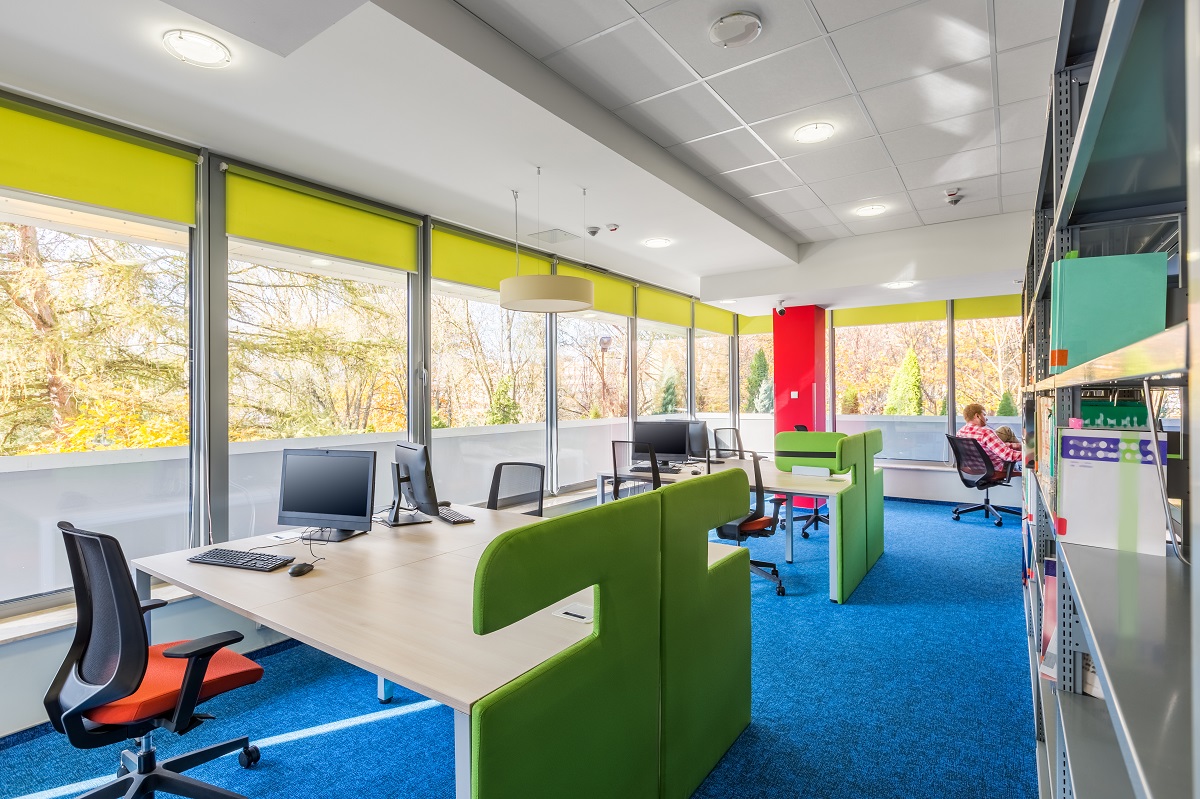Whether a business starts life on the kitchen table or in a shared space, at some point, important decisions will need to be made about the most appropriate workspace. It’s likely cost and size will drive your workspace decision, but there are also other important factors to consider…
Location, location, location
In an ideal world, many small business owners would like to choose the location of their workspace based on price, but it’s rarely that simple. For some businesses, it’s essential to be close to their clients or customers, which could mean you have to pay more than you might like.
The location also influences other factors such as recruitment. It’s beneficial to be in an area where there are prospective candidates with the skills you need or an area that candidates would be willing to relocate to. Of course, being close to parking, public transport, food, amenities and green space is also a benefit for employees.
What about a co-workspace?
Rather than having to buy, rent or lease your own private office, a co-workspace could provide the flexibility and facilities you need while reducing the costs. While some spaces cater for a diverse range of businesses, others focus on a particular sector and create an environment that’s tailored to the particular requirements of those business types.
As well as reducing the costs, there are also benefits associated with surrounding yourself with those involved in similar and complementary sectors. Co-workspaces also provide plenty of flexibility, allowing you to increase the size of the space you pay for as you grow.
Consider current needs and future growth
When choosing your workspace, make sure it doesn’t just suit your needs now but also provides the flexibility you need to grow. Before you sign a long-term lease, stop and think about what your business will look like over the next few years. Flexibility is vital, so look for space you could potentially expand into, negotiate a shorter lease or agree one that allows you to exit if you need to.
Technological requirements
With modern workplaces more connected than ever before and many businesses having remote workers and outsourced teams, it’s essential your workspace provides smooth and efficient access to the latest technology. That means having the necessary infrastructure to support fast internet and Wi-Fi in shared and public areas.
Functionality and visual appeal
The look of your workspace inside and out will have an impact on the way employees, clients and other stakeholders view your business. But as well as looking the part, it also needs to be a comfortable and professional space that supports the way you and your employees work. It should also help to maintain the wellness of your team, with meeting areas, breakout spaces and facilities that allow your staff to cycle or run to work if they choose to.
Overall, take your time
Although cost and size will be the two main factors that drive your workspace decision, always do your homework and make sure you consider all the services and facilities your business needs before you sign on the dotted line.
Whether a business starts life on the kitchen table or in a shared space, at some point, important decisions will need to be made about the most appropriate workspace. It’s likely cost and size will drive your workspace decision, but there are also other important factors to consider…
Location, location, location
In an ideal world, many small business owners would like to choose the location of their workspace based on price, but it’s rarely that simple. For some businesses, it’s essential to be close to their clients or customers, which could mean you have to pay more than you might like.
The location also influences other factors such as recruitment. It’s beneficial to be in an area where there are prospective candidates with the skills you need or an area that candidates would be willing to relocate to. Of course, being close to parking, public transport, food, amenities and green space is also a benefit for employees.
What about a co-workspace?
Rather than having to buy, rent or lease your own private office, a co-workspace could provide the flexibility and facilities you need while reducing the costs. While some spaces cater for a diverse range of businesses, others focus on a particular sector and create an environment that’s tailored to the particular requirements of those business types.
As well as reducing the costs, there are also benefits associated with surrounding yourself with those involved in similar and complementary sectors. Co-workspaces also provide plenty of flexibility, allowing you to increase the size of the space you pay for as you grow.
Consider current needs and future growth
When choosing your workspace, make sure it doesn’t just suit your needs now but also provides the flexibility you need to grow. Before you sign a long-term lease, stop and think about what your business will look like over the next few years. Flexibility is vital, so look for space you could potentially expand into, negotiate a shorter lease or agree one that allows you to exit if you need to.
Technological requirements
With modern workplaces more connected than ever before and many businesses having remote workers and outsourced teams, it’s essential your workspace provides smooth and efficient access to the latest technology. That means having the necessary infrastructure to support fast internet and Wi-Fi in shared and public areas.
Functionality and visual appeal
The look of your workspace inside and out will have an impact on the way employees, clients and other stakeholders view your business. But as well as looking the part, it also needs to be a comfortable and professional space that supports the way you and your employees work. It should also help to maintain the wellness of your team, with meeting areas, breakout spaces and facilities that allow your staff to cycle or run to work if they choose to.
Overall, take your time
Although cost and size will be the two main factors that drive your workspace decision, always do your homework and make sure you consider all the services and facilities your business needs before you sign on the dotted line.
Whether a business starts life on the kitchen table or in a shared space, at some point, important decisions will need to be made about the most appropriate workspace. It’s likely cost and size will drive your workspace decision, but there are also other important factors to consider…
Location, location, location
In an ideal world, many small business owners would like to choose the location of their workspace based on price, but it’s rarely that simple. For some businesses, it’s essential to be close to their clients or customers, which could mean you have to pay more than you might like.
The location also influences other factors such as recruitment. It’s beneficial to be in an area where there are prospective candidates with the skills you need or an area that candidates would be willing to relocate to. Of course, being close to parking, public transport, food, amenities and green space is also a benefit for employees.
What about a co-workspace?
Rather than having to buy, rent or lease your own private office, a co-workspace could provide the flexibility and facilities you need while reducing the costs. While some spaces cater for a diverse range of businesses, others focus on a particular sector and create an environment that’s tailored to the particular requirements of those business types.
As well as reducing the costs, there are also benefits associated with surrounding yourself with those involved in similar and complementary sectors. Co-workspaces also provide plenty of flexibility, allowing you to increase the size of the space you pay for as you grow.
Consider current needs and future growth
When choosing your workspace, make sure it doesn’t just suit your needs now but also provides the flexibility you need to grow. Before you sign a long-term lease, stop and think about what your business will look like over the next few years. Flexibility is vital, so look for space you could potentially expand into, negotiate a shorter lease or agree one that allows you to exit if you need to.
Technological requirements
With modern workplaces more connected than ever before and many businesses having remote workers and outsourced teams, it’s essential your workspace provides smooth and efficient access to the latest technology. That means having the necessary infrastructure to support fast internet and Wi-Fi in shared and public areas.
Functionality and visual appeal
The look of your workspace inside and out will have an impact on the way employees, clients and other stakeholders view your business. But as well as looking the part, it also needs to be a comfortable and professional space that supports the way you and your employees work. It should also help to maintain the wellness of your team, with meeting areas, breakout spaces and facilities that allow your staff to cycle or run to work if they choose to.
Overall, take your time
Although cost and size will be the two main factors that drive your workspace decision, always do your homework and make sure you consider all the services and facilities your business needs before you sign on the dotted line.




